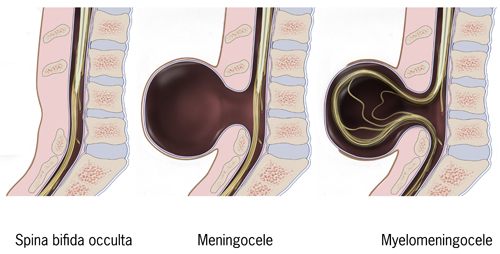In continuing our mission to help education people on what Spina Bifida (SB) is, this post is dedicated to the types of SB. There are actually 4 types of SB - occulta, closed neural tube defects, meningocele, and myelomeningocele.
Occulta is the mildest and most common form of SB. The word "occulta" actually means hidden. With SB occulta the malformation or spinal defect is covered by a layer of skin. With SB occulta, most people have little to no effects or disabilities. Often it is not discovered until later in childhood or adulthood.
Closed Neural Tube Defects is the second form of SB. With the closed neural tube defects, the spinal cord is marked by a deformity of fat, bone or membranes. Like SB occulta, individuals with the closed neural tube defect SB experience little to no symptoms. Sometimes the deformity can cause bladder or bowl dysfunction or mild mobility impairments.
Meningocele is the third type of SB. With meningocele, spinal fluid and meninges (membranes that envelope the central nervous system) form a sac on the back of a baby. There is usually no nerve damage and the individual experiences little to no symptoms. In some cases meningocele can cause minor disabilities.
Myelomeningocele is the final form of SB and it is also considered the most severe. It occurs when the spinal cord, nerves and other nerve elements physically protrude through an opening in the back. Depending on where the opening is, depends on how severe the disability could be. It can cause paralysis, bowel and bladder dysfunction and other disabilities including Hydrocephalus.
Alex's Army is most familiar with the Myelomeningocele for of SB because that is what Alex was diagnosed with when he was born. His SB is located at the T11/T12 area of his vertebra. He has no movement from the waste down and does experience the other symptoms discussed above.
For more information about the types of SB, please check out these helpful websites:
